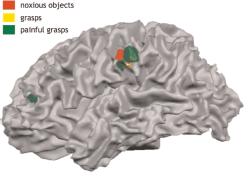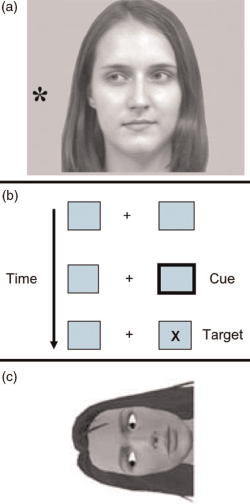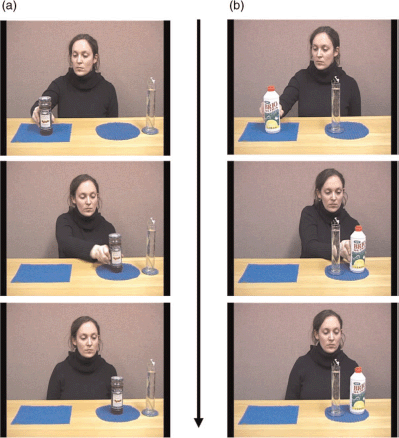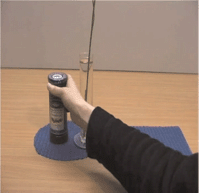From observation to action simulation: the role of attention, eye-gaze, emotion, and body state
- PMID: 20721814
- PMCID: PMC2988435
- DOI: 10.1080/17470211003624002
From observation to action simulation: the role of attention, eye-gaze, emotion, and body state
Abstract
This paper reviews recent aspects of my research. It focuses, first, on the idea that during the perception of objects and people, action-based representations are automatically activated and, second, that such action representations can feed back and influence the perception of people and objects. For example, when one is merely viewing an object such as a coffee cup, the action it affords, such as a reach to grasp, is activated even though there is no intention to act on the object. Similarly, when one is observing a person's behaviour, their actions are automatically simulated, and such action simulation can influence our perception of the person and the object with which they interacted. The experiments to be described investigate the role of attention in such vision-to-action processes, the effects of such processes on emotion, and the role of a perceiver's body state in their interpretation of visual stimuli.
Figures













Similar articles
-
Predicting others' actions via grasp and gaze: evidence for distinct brain networks.Psychol Res. 2012 Jul;76(4):494-502. doi: 10.1007/s00426-011-0393-9. Epub 2011 Nov 27. Psychol Res. 2012. PMID: 22120203
-
Implicitly perceived objects attract gaze during later free viewing.J Vis. 2009 Jun 10;9(6):6.1-12. doi: 10.1167/9.6.6. J Vis. 2009. PMID: 19761297
-
Use of context in emotion perception: The role of top-down control, cue type, and perceiver's age.Emotion. 2015 Jun;15(3):292-302. doi: 10.1037/emo0000062. Emotion. 2015. PMID: 25985276
-
How do children learn to follow gaze, share joint attention, imitate their teachers, and use tools during social interactions?Neural Netw. 2010 Oct-Nov;23(8-9):940-65. doi: 10.1016/j.neunet.2010.07.011. Epub 2010 Aug 5. Neural Netw. 2010. PMID: 20817477 Review.
-
Neural mechanisms of social attention.Trends Cogn Sci. 2009 Mar;13(3):135-43. doi: 10.1016/j.tics.2008.12.006. Epub 2009 Feb 14. Trends Cogn Sci. 2009. PMID: 19223221 Review.
Cited by
-
Gaze and body cues interplay during interactive requests.PLoS One. 2019 Oct 21;14(10):e0223591. doi: 10.1371/journal.pone.0223591. eCollection 2019. PLoS One. 2019. PMID: 31634344 Free PMC article.
-
A Central Component of the N1 Event-Related Brain Potential Could Index the Early and Automatic Inhibition of the Actions Systematically Activated by Objects.Front Behav Neurosci. 2019 May 8;13:95. doi: 10.3389/fnbeh.2019.00095. eCollection 2019. Front Behav Neurosci. 2019. PMID: 31139060 Free PMC article.
-
Predicting others' actions via grasp and gaze: evidence for distinct brain networks.Psychol Res. 2012 Jul;76(4):494-502. doi: 10.1007/s00426-011-0393-9. Epub 2011 Nov 27. Psychol Res. 2012. PMID: 22120203
-
Gaze and Arrows: The Effect of Element Orientation on Apparent Motion is Modulated by Attention.Vision (Basel). 2017 Aug 22;1(3):21. doi: 10.3390/vision1030021. Vision (Basel). 2017. PMID: 31740646 Free PMC article.
-
Priorities for selection and representation in natural tasks.Philos Trans R Soc Lond B Biol Sci. 2013 Sep 9;368(1628):20130066. doi: 10.1098/rstb.2013.0066. Print 2013 Oct 19. Philos Trans R Soc Lond B Biol Sci. 2013. PMID: 24018727 Free PMC article.
References
-
- Barsalou L. W. Situated simulation in the human conceptual system. Amsterdam: Elsevier; 2003.
-
- Bayliss A. P., di Pellegrino G., Tipper S. P. Orienting of attention via observed eye-gaze is head-centred. Cognition. 2004;94:B1–B10. - PubMed
Publication types
MeSH terms
Grants and funding
LinkOut - more resources
Full Text Sources
